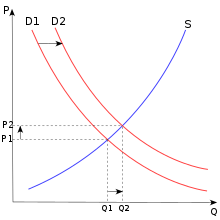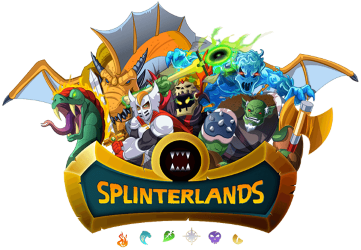Splinterlands Economics: Demand
Hello everyone! We are back again today with another edition of Splinterland Economics - a series in which we introduce a basic economic concept and then apply it to Splinterlands. If this is your first time reading, just to tell you a little bit about myself: my day job is in an unrelated area but I consider myself a little bit of economics nerd - I read a little (or maybe way, way) more news than I should, double majored in econ, and am obsessed with optimization. I love the way Splinterlands is equal parts card game and resource allocation game. My goal with these articles is to share a little bit of what I know with you all.
Our subject today is half of what determines the prices of goods in the marketplace, and goes hand in hand with the topic of last week's post. In addition to being a term for making a strong request, it also describes an important aspect of consumer behavior in markets. If you have been reading along regularly then you probably already suspected that this subject was coming up soon - today we will be talking about Demand!

What is demand?
Demand is the amount of a good or service that people are willing to purchase at a given price point. If you have been following this series, then you may recall from our discussion last week that if you were to list out all of the possible prices a good could sell for and then figure out how much of that good producers would be willing to make for that price, then you would get the supply curve. You can do the exact same thing with consumers and determine how much each person would be willing to play in order to plot out a demand curve. For a marketplace, the demand curve is the total of the individual demands of every consumer who uses that marketplace.
The exact shape of the demand curve is determined by a number of factors including, among other things, how useful the good is, the availability of similar goods (or "substitutes"), and consumer expectations for the future. The steepness of the demand curve, as well as its position in terms of absolute numbers, is dependent on these factors. In general, the demand curve will be downward sloping - this means that as prices increase, the quantity demanded will decrease.

There are a number of events that can occur which can cause demand to either increase or decrease, causing a shift in the demand curve. A change to any of the factors determining the demand curve's shape can result in a change in demand. For example, if a good has newly discovered uses then people may be willing to buy more of it at each price level, and demand will increase. If another good which is similar (or perhaps even superior) enters the marketplace, then demand will most likely decrease since consumers will become more price sensitive - if the price of the particular good we are looking at increases, then consumers will simply switch to purchasing the other good. There are countless other examples of events which can impact demand, and one of my favorite activities while reading the news is looking at the headlines and trying to figure out how they will impact demands and future expectations.
How do we apply it to Splinterlands?
Splinterlands is a game with many moving parts, including assets with various uses. The most common asset type is cards. The main use case for cards (at least for now) is to be played in ranked battles and tournaments in order to earn ranked play rewards. We can look at the same factors for real-life goods in order to analyze demand for these NFTs. For example, a card's usefulness is tied to the amount of winnings that it can help a player to earn. If a card is particularly useful in order to help win a battle then its demand will be higher. Similarly, if it can help a player to win a greater amount of rShares by virtue of being a gold foil, or an alpha or beta card, then that also gives it additional value. On the other hand, if a card fills a function which is easily replaced by other cards or is not a part of the meta at all then the demand for it may be dramatically lower.
The fact that Splinterlands is a quickly changing game means that "shocks" or changes to demand happen often as the developers add features and functionalities and players adjust accordingly. For example, land is a game feature which has been in development for a while now and the developers have hinted that it will contain a mechanic giving additional utility to older cards. The rewards system dictating how players earn according to the leagues they play in is also a work in progress and sees relatively frequent changes and updates. Actions such as these are a source of frequent demand shocks and price fluctuations in the game markets, and are a reason that some players pay such close attention to everything the game developers publish in papers and articles or say in streamed events such as the weekly town halls.
One more note on demand in Splinterlands that I have to point out is that it is important to remember that the demand curve is the aggregate of all the consumers in the marketplace. Change to the demand curve can occur through change to the mechanics of the good in question or through changes in consumer preferences. But an additional way for the demand curve to change is through the addition of additional consumers to the marketplace. That is why new player acquisition and retention is so important, to Splinterlands as well as any other game involving assets with value. More players mean increasing asset prices, as well as more people to play and interact with!
Why should we care?
Understanding how demand works gives us additional insight into how markets work, helping us to figure out why certain items are priced the way they are. And this knowledge is not purely academic - it can also help us to more accurately predict how the prices of goods and services will behave in the future. Whether you are managing your assets in Splinterlands or in the real world, keeping the mechanics of demand in mind while deciding how to allocate our resources can pay dramatic dividends over time.
Thank you so much for reading all the way to the end. Interested in seeing some more of my writing in the future? Be sure to give me a follow! In the meantime, if you'd like to see some of my recent posts:
Splinterlands Economics: Supply - A look into Supply, and how understanding it can help us in Splinterlands.
Striking Out - Using Tenyii Striker in Battle! - Last week's battle challenge, featuring Tenyii Striker!
Splinterlands Economics: Markets - A discussion of markets, and their role in Splinterlands.
Thinking about giving Splinterlands a try but haven't signed up yet? Feel free to use my referral link: https://splinterlands.com?ref=bteim, and be sure to reach out to me if you have any questions!
All images used in this article are open source and obtained from Pixabay or Unsplash. Thumbnails borrowed with permission from the Splinterlands team or made in Canva.



Congratulations @bteim! You have completed the following achievement on the Hive blockchain and have been rewarded with new badge(s):
Your next target is to reach 15000 upvotes.
You can view your badges on your board and compare yourself to others in the Ranking
If you no longer want to receive notifications, reply to this comment with the word
STOPCheck out the last post from @hivebuzz:
Thanks for sharing! - @alokkumar121
